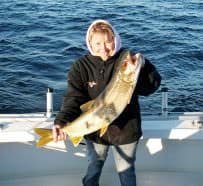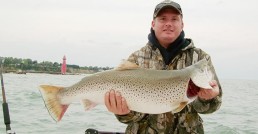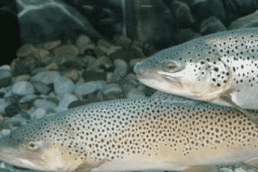Springtime is Brown Trout Time
SHARE THIS POST
Got that itch for open water fishing? Now is the time to scratch it with some brown trout action. Early spring is that magical time of the year when you can launch your boat in the morning and troll the shallows of Lake Michigan for brown trout and then slide up to Green Bay and walk out on the ice and pop a couple of nice walleyes in the evening. Every year it’s a waiting game for that magical day that the launching ramp is ice-free and we can back the Starcraft down the launch ramp and get after those “silver footballs.”
Depending on the year, and Mother Nature, it doesn’t take long for the word to get out that browns are biting. That’s because after a long winter of being left alone, they are biting. They are cruising the shallow rocky shoreline of Lake Michigan feeding on gobies, stonerollers and other small baitfish that inhabit the structured shoreline.
Since the bay and other inland lakes are still ice covered at this time of year, it’s a no-brainer to grab my Ugly Stik GX2’s and Alphamar 16s spooled with 50-pound Stren Sonic Braid and 10-pound Trilene fluorocarbon leaders and hit the boat landing with a vengeance to tackle a few of those monster browns that are cruising the shoreline. Those first couple weeks can be some of the best since the browns have had all winter to forget about being chased and they are hungry and aggressive. A couple of Rapala #7 or #9 floaters or a Rebel Fastrac are favorite weapons when cruising the shallow 8 to 12 feet in early season. Black/Silver, Black/Gold, Blue/Silver and FireTiger are their popular colors.

I like to pay close attention to my graph and the surface temperature as I’m trolling. I have found that often times, the areas where I get my bites are quite often patches of cloudy water where the water temperature can rise as little as 1 to 2 degrees and in those areas, the bait fish will tend to congregate and attract the hungry browns. When I find one of those patches, I will circle back and make several passes through that area and often pick up a fish or two and each pass through those cloudy patches. You will also find that the darker and more colorful baits like firetiger and black/gold colors will work the best in the cloudy areas, as they tend to look the most like the gobies that the brown trout are feeding on.
As a bonus, you may also pick up a few lake trout in the shallows in early spring. They too are cruising the rocky shoreline, feeding on those same gobies that the browns are chasing. For this reason, I also like to toss out a couple orange/gold Rapalas in my spread. Lake trout love orange and there is nothing like a good lake trout filet on the grill from the spring cold water.
Since these brown and lake trout are in the rocky shallows feeding on gobies, I have found downward swimming action of the Berkley Flicker Shads and Flicker Minnows that seem to imitate the gobies are quite deadly at times. I like the colors that closely resemble the gobies, like black/gold, black/gold sunset, slick sunset and firetiger. These seem to work very well as the sun is coming up.
Are you enjoying this post?
You can be among the first to get the latest info on where to go, what to use and how to use it!
After you’ve made that first couple passes in the really shallow water in the early dawn hours, you will notice the bite slowing as the sun gets higher in the sky. This is when I like to slide out and work that 15 to 30 feet of water. The browns and lakers don’t go away, but they do get a bit sketchy in that clear, shallow water and will tend to slide a bit deeper once the sun gets a bit higher in the sky. This opens up more options in my spread. I will trade a couple of planner boards for my slide divers and bust out a couple super light R & R spoons. Slide divers work great for this because I can dial them to run out from the boat and also put a 50- to 60-foot leader behind the diver—a deadly combination on these hesitant browns and lake trout.
Being a little deeper will also let you use your downriggers if you have them. Just like the slide divers, I set my riggers with longer 60- or even 80-foot leads and run them shallow, like 8 to 10 feet down. By getting the baits back a ways from the boat, the browns, especially in the cloudier water, will be comfortable striking baits that far back from the boat.
Lee Haasch is an Algoma charter captain with 40-plus years Great Lakes fishing experience. He’s been writing and giving seminars for 25-plus years.
For more information…
For current fishing reports or information on charter fishing check out Capt. Haasch’s report page at www.FishAlgoma.com.
TIP OF THE MONTH:
Stealth approach—hide your line. When I am fishing the shallow spring waters of Lake Michigan for brown and lake trout, I pay very close attention to my line. Many days the water clarity is very clear. Using a stealth approach is critical to your success. My Alphamar16LCs are spooled with Stren Sonic Braid in 30-pound test. I use a small, clear, plastic bead and tie on a small barrel swivel. My 8-foot leaders are 10-pound Trilene, 100% Professional Grade Fluorocarbon. The plastic bead serves to not only protect the knot from wear when your planner board slides down the line, but it is also the stopper for the board, so it doesn’t slide to the bait and knock the fish off. Keep the spool of fluorocarbon in the your tackle box and while today’s line is much tougher and abrasion resistant compared to years ago, your line is running close to bottom at times and zebra mussels are sharp and can nick your line, as can the fish’s teeth. I run my fingers down the line after every fish, and if nicked, I retie my leader. Use Trilene Fluorocarbon to hide your line and watch your fish cooler fill up.
MWO
SHARE THIS POST
Did you enjoy this post?
You can be among the first to get the latest info on where to go, what to use and how to use it!
Lee Haasch
Capt. Lee Haasch is a charter captain out of Algoma, Wis., with more than 45 years of Great Lakes angling and guiding experience. Haasch has been instructing anglers for over 30 years with education seminars and timely freelance articles.



